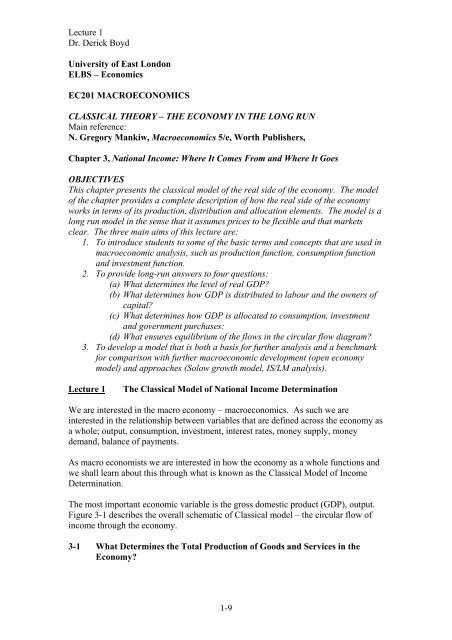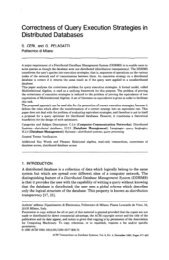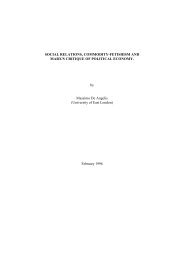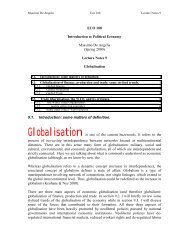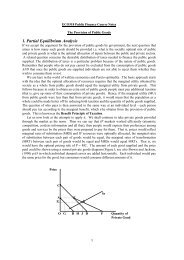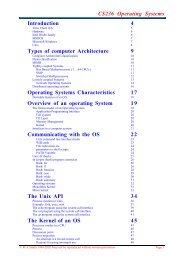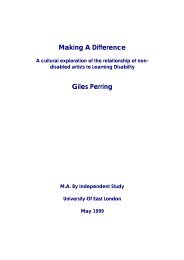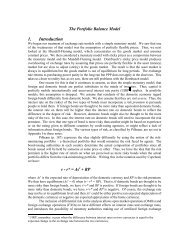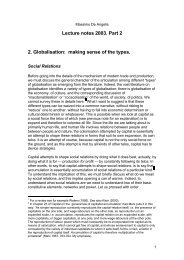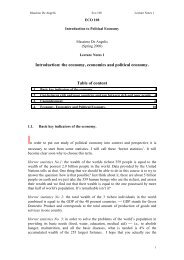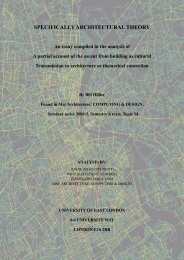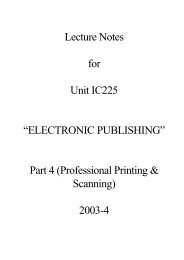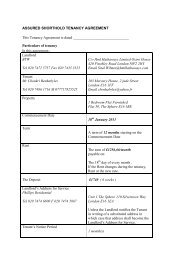FE2001 Lect 1 Chapter 3, National Income - Personal Home Pages ...
FE2001 Lect 1 Chapter 3, National Income - Personal Home Pages ...
FE2001 Lect 1 Chapter 3, National Income - Personal Home Pages ...
You also want an ePaper? Increase the reach of your titles
YUMPU automatically turns print PDFs into web optimized ePapers that Google loves.
<strong>Lect</strong>ure 1<br />
Dr. Derick Boyd<br />
University of East London<br />
ELBS – Economics<br />
EC201 MACROECONOMICS<br />
CLASSICAL THEORY – THE ECONOMY IN THE LONG RUN<br />
Main reference:<br />
N. Gregory Mankiw, Macroeconomics 5/e, Worth Publishers,<br />
<strong>Chapter</strong> 3, <strong>National</strong> <strong>Income</strong>: Where It Comes From and Where It Goes<br />
OBJECTIVES<br />
This chapter presents the classical model of the real side of the economy. The model<br />
of the chapter provides a complete description of how the real side of the economy<br />
works in terms of its production, distribution and allocation elements. The model is a<br />
long run model in the sense that it assumes prices to be flexible and that markets<br />
clear. The three main aims of this lecture are:<br />
1. To introduce students to some of the basic terms and concepts that are used in<br />
macroeconomic analysis, such as production function, consumption function<br />
and investment function.<br />
2. To provide long-run answers to four questions:<br />
(a) What determines the level of real GDP?<br />
(b) What determines how GDP is distributed to labour and the owners of<br />
capital?<br />
(c) What determines how GDP is allocated to consumption, investment<br />
and government purchases:<br />
(d) What ensures equilibrium of the flows in the circular flow diagram?<br />
3. To develop a model that is both a basis for further analysis and a benchmark<br />
for comparison with further macroeconomic development (open economy<br />
model) and approaches (Solow growth model, IS/LM analysis).<br />
<strong>Lect</strong>ure 1 The Classical Model of <strong>National</strong> <strong>Income</strong> Determination<br />
We are interested in the macro economy – macroeconomics. As such we are<br />
interested in the relationship between variables that are defined across the economy as<br />
a whole; output, consumption, investment, interest rates, money supply, money<br />
demand, balance of payments.<br />
As macro economists we are interested in how the economy as a whole functions and<br />
we shall learn about this through what is known as the Classical Model of <strong>Income</strong><br />
Determination.<br />
The most important economic variable is the gross domestic product (GDP), output.<br />
Figure 3-1 describes the overall schematic of Classical model – the circular flow of<br />
income through the economy.<br />
3-1 What Determines the Total Production of Goods and Services in the<br />
Economy?<br />
1-9
<strong>Lect</strong>ure 1<br />
Dr. Derick Boyd<br />
An economy’s output depends on (1) its quantity of inputs, called the factors of<br />
production, and (2) it ability to turn inputs into output, as represented by the<br />
production function.<br />
The Factors of Production<br />
( K = K, L= L)<br />
The Production Function<br />
Y = F( K, L)<br />
This says simple that the amount of GDP an economy can produce depends upon its<br />
capital stock K and its labour L. More K and K allows more output to be produced.<br />
1/2<br />
For example, given a production function of the form Y = ( K L)<br />
where K=40 and<br />
1/2<br />
L=10, Y= (400) = 20.<br />
Some production functions have a property called constant returns to scale (CRS).<br />
This means that if the inputs increase by a certain percentage z, then output would<br />
increase by the same percentage.<br />
1/2<br />
The production function Y = ( K L)<br />
is a CRS pf. If the factors increase by 25% each<br />
then it can be shown that Y will also increase by 25%. If K and L double then Y will<br />
also double.<br />
The Supply of Goods and Services<br />
We can now see that the factors of production and the production function together<br />
determine the quantity of goods produced/supplied. In this simple start an economy<br />
with K, L and technology (the transforming function) fixed, we would have a fixed<br />
level of Y: Y = F( K, L) = Y .<br />
Okay, so now we have a model so far of how the output is produced in the economy<br />
but how is the output distributed to the people in the economy?<br />
3-2 How is <strong>National</strong> <strong>Income</strong> Distributed in the Economy?<br />
The answer to this question in the Classical model is provided by the Marginal<br />
Productivity Theory of Distribution, also known as the Neoclassical Theory of<br />
Distribution. In this model/theory only people who own the factors of production that<br />
takes part in the process of production gets any part of the output. So, the short<br />
answer is that the output is distributed to the factors of production.<br />
In this theory the national income is distributed through factor prices.<br />
There is a market for each of the factors of production, e.g. the labour market, and<br />
demand and supply in that market will determine the prices paid to the factor – the<br />
wage.<br />
Let us see how a typical firm determines how much of these factors to employ and<br />
how much the factors will be paid.<br />
2-9
<strong>Lect</strong>ure 1<br />
Dr. Derick Boyd<br />
Factor Price<br />
Equilibrium<br />
factor price<br />
Fixed supply of<br />
factor/input<br />
Factor Demand<br />
Qty of Factor<br />
Let us suppose that the firm is a small competitive firm, so it is a price taker in the<br />
market and not able to influence the factor prices – it can only really decide on how<br />
much of the factor to employ, in this case.<br />
Firms sell at P, hire workers at W and rents capital at R. The firm seeks to maximise<br />
profits.<br />
Profits = R – C,<br />
R = P.Y C = labour costs (W.L) + capital costs (R.K)<br />
Profits = P. Y– WL - RK = P. F(K,L) – WL – RK<br />
The competitive firm takes the product price P and the factor prices W and R as given<br />
an chooses the level of K and L that will maximise profit. How do they chose the K<br />
and L?<br />
The short answer is that they hire the L associated with MPL = W/P and the MPK =<br />
R/P.<br />
Let us consider the case of labour.<br />
MPL = P.∆Y = MRPL = P.F(K,L+1) – P.F(K,L)<br />
P.∆Y is the change in revenue from employing one additional unit of labour.<br />
3-9
<strong>Lect</strong>ure 1<br />
Dr. Derick Boyd<br />
Output, Y<br />
1<br />
1<br />
The slope of the<br />
production function<br />
is the MPL.<br />
FKL ( , )<br />
As more<br />
labour is<br />
added, the<br />
MPL declines<br />
Labour, L<br />
Most production functions have the property of diminishing marginal returns – as<br />
more of a factor is employed the change in the output will decrease as additional<br />
factors are employed.<br />
P.∆Y = P.MPL = W (nominal wage). This can be rewritten as,<br />
MPL = W/P This says that the firm will hire workers until the marginal product of<br />
labour is equal to the real wage.<br />
The same considerations underlie the decision about K.<br />
MPK = P.∆Y = MRPK = P.F(K+1,L) – P.F(K,L)<br />
Firms will rent K up to where P.MPK = R (nominal interest rate) and this can be<br />
written, MPK=R/P. This says that the firm will hire workers until the marginal<br />
product of capital is equal to the real rental price of capital.<br />
Having now examined the mechanisms that determine how much each factor of<br />
production is demanded and paid, we can now explain how the total product is<br />
distributed in the economy.<br />
The Division of <strong>National</strong> <strong>Income</strong><br />
Since each factor of production is paid an amount equal to its marginal contribution to<br />
output, total real payments to labour (W/P.L) must be equal to its total real<br />
contribution to output and total real payments to capital (R/P.K) must be equal to its<br />
total real contribution to output. Since only labour and capital contribute to output<br />
and they get what they contribute then the sum of the payments must be equal to total<br />
output.<br />
(W/P.L) + (R/P.K) = (MPL.L) + (MPK.K) = Y<br />
If each of the factors of production is paid its marginal product and the sum of the<br />
payments is equal to total output then where does profits come from? The response to<br />
this is that really what we call profits is really part of the payments to capital. People<br />
own L and K but firms also own K. So while we see the payment to L as wages and<br />
the payment to people who own K as interest, we account for the payment to firms<br />
who own K as profits. There is a big debate about this and indeed as to what capital is<br />
… It is enough for us to understand that in this Neoclassical Theory of Distribution,<br />
4-9
<strong>Lect</strong>ure 1<br />
Dr. Derick Boyd<br />
output is distributed throughout the economy on the basis of the contribution of the<br />
factors of production to the production process.<br />
So, we have production taking place and now households have income based on the<br />
marginal productivity theory of distribution. How are these incomes used? – well, the<br />
group of people who receive the income use them to demand goods and services. Let<br />
us now see how this is explained in the Classical Model.<br />
3-3 What Determines the Demand for Goods and Services<br />
So, we have seen that F(K,L) = Y = GDP and this is distributed to the factors of<br />
production, now we will see how that income is used. Total income is essentially<br />
used to demand the goods and services produced and four types of purchases are<br />
generally identified: consumption, investment, government and net exports.<br />
Consumption<br />
Households (labour and capital owning households) receive income Y.<br />
Households pay taxes T that provides the government with its revenue/income.<br />
Household disposable income is then (Y-T)<br />
Households divide their income between consumption C and savings S.<br />
Consumption is modelled as determined by C = C(Y – T), a consumption function.<br />
The MPC tells us the proportion of income that is spent from a unit of disposable<br />
income (pound).<br />
Consumption, C<br />
1<br />
Consumption function<br />
MPC<br />
Disposable <strong>Income</strong>, Y - T<br />
The proportion by which consumption changes when disposable income increases by<br />
one pound is called the MPC.<br />
So consumption is determined through a consumption function.<br />
Investment<br />
Both firms and households demand investment goods. Firms both replace and add to<br />
their capital stock, and households buy new homes.<br />
The quantity of investment goods and services demanded depends on the interest rate.<br />
This is so whether or not firms have to borrow the funds – give example.<br />
5-9
<strong>Lect</strong>ure 1<br />
Dr. Derick Boyd<br />
We have to distinguish between nominal and real interest rates. This distinction is<br />
important and especially so when price are changing. Nominal interest rate R is the<br />
one usually report, 8%. Real interest rate r is nominal interest rate minus the rate of<br />
inflation, r = R – inf = 8% - 3% = 5%, for example. The real interest rate measures<br />
the true cost of borrowing and thus determines the quantity of investment. We can<br />
write a function for investment as I = I(r).<br />
Government Purchases<br />
Central government purchases missiles, computers, services,…<br />
Local government purchase library books, road cleaning services, ..<br />
Government make transfer payments such as welfare and social security payments.<br />
These are not made in exchange for any good or service. Transfer payments are the<br />
opposite of taxes – they increase household disposable income in the same way taxes<br />
reduce disposable income. Thus an increase in transfer payments financed by<br />
increased taxes leave household income unchanged. We define T as taxes minus<br />
transfer payments: Ttaxes = T – Ttp.<br />
If government purchase G = T then the government has a balanced budget.<br />
If G > T then the government has a budget deficit.<br />
If G < T then the government has a budget surplus.<br />
For simplicity we model G and T as exogenous variables: ( G = G, T = T) .<br />
• We have looked firstly at how total income/output Y = F( K, L)<br />
is<br />
produced/supplied.<br />
• We looked at how the total income is distributed to households and firms.<br />
• We just looked at how demand for total output is determined.<br />
• Now we need to develop an explanatory of how the Supply and Demand are<br />
brought into equilibrium in the economy.<br />
3-4 What Brings the Supply and Demand for Goods and Services into<br />
Equilibrium?<br />
In other words, what ensures that the sum of consumption, investment and<br />
government purchases (C + I + G) equals the amount of output produced Y. We will<br />
see that in this Classical Model, the interest rate has the crucial role of equilibrating<br />
supply and demand.<br />
On the Supply side we saw that,<br />
Y = F( K, L)<br />
~ Y = F( K, L) = Y<br />
and on the Demand side,<br />
Y = C + I + G ~ Y = C+ I() r + G<br />
C = C(Y – T) ~ C = C( Y − T)<br />
I = I(r) ~ I = I(r)<br />
G = G<br />
T = T<br />
~<br />
G = G<br />
T = T<br />
6-9
<strong>Lect</strong>ure 1<br />
Dr. Derick Boyd<br />
<strong>National</strong> savings is Y – C – G = S and this is equal to investment I.<br />
Y – C – G = I ~ Y − C− G = I<br />
S = I(r) ~ S = I() r<br />
For fixed values of Y, G and T, national saving S will also be fixed.<br />
In the model now r adjusts to ensure equilibrium between S and I and this brings<br />
about a general equilibrium in the economy.<br />
Real interest rate, r<br />
*<br />
r<br />
S<br />
I(r)<br />
Qty of Savings, Investments<br />
At the equilibrium interest rate, households desire to save balances firms’ desire to<br />
invest, and the quantity of loanable funds supplied equals the quantity demanded –<br />
this is the classical Loanable Funds Theory of Interest Rate Determination.<br />
<strong>National</strong> Savings S can be broken down into Private Savings Sp and<br />
public/government savings Sg, S = Sp + Sg so that<br />
Y – C – G = (Y – T – C) + (T – G) = I(r) ~ ( Y −T − C) + ( T − G) = S = I( r)<br />
100 + 0 = 100 = r *<br />
100 + 10 = 110 = r * ↓<br />
100 - 20 = 80 = r * ↑<br />
Discuss the impact of government surplus/deficit on the equilibrium real interest rate<br />
and its impact on output in the economy.<br />
7-9
<strong>Lect</strong>ure 1<br />
Dr. Derick Boyd<br />
Real interest rate, r<br />
r s1<br />
r s2<br />
S 2<br />
S1<br />
Summary<br />
1. The factors of production and the production technology determine the<br />
economy’s output of goods and services. An increase in one of the factors of<br />
production or a technological advance raises output.<br />
2. Competitive, profit-maximising firms hire labour until the marginal product of<br />
labour equals the real wage. Similarly, these firms rent capital until the<br />
marginal product of capital equals the real rental price. Therefore, each factor<br />
of production is paid its marginal product. If the production function has<br />
constant returns to scale, all output is used to compensate the inputs.<br />
3. The economy’s output is used for consumption, investment and government<br />
purchases. Consumption depends positively on disposable income.<br />
Investment depends negatively on the real interest rate. Government<br />
purchases and taxes are exogenous variables of fiscal policy.<br />
4. The real interest rate adjusts to equilibrate the supply and demand ofr the<br />
economy’s output – or equivalently, to equilibrate the supply of loanable fund<br />
(savings) and the demand for loanable funds (investment). A decrease in<br />
national saving, perhaps because of an increase in government purchases or a<br />
decrease in taxes, reduces the equilibrium amount of investment and raises the<br />
interest rate. An increase in investment demand, perhaps because of a<br />
technological innovation or a tax incentive for investment, also raises the<br />
interest rates. An increase in investment demand increases the quantity of<br />
investment only if higher interest rates stimulate additional savings.<br />
I(r)<br />
80 Qty of Savings, Investments<br />
100<br />
8-9
<strong>Lect</strong>ure 1<br />
Dr. Derick Boyd<br />
QUESTIONS<br />
Review Questions<br />
1. What determines the amount of output an economy produces?<br />
2. Explain how a competitive, profit-maximising firm decides how much of each<br />
factor of production to demand.<br />
3. What is the role of constant returns to scale the model of how income is<br />
distributed?<br />
4. What determines consumption and investment?<br />
5. Explain the difference between government purchases and transfer payments.<br />
Give two examples of each.<br />
6. What makes the demand for the economy’s output of goods and services equal<br />
the supply?<br />
7. Explain what happens to consumption, investment and the interest rate when<br />
the government increases taxes.<br />
Main Questions<br />
1. Use the classical model approach to answer the following questions.<br />
(a) What determines the level of real GDP?<br />
(b) What determines how GDP is distributed to labour and the owners of<br />
capital?<br />
(c) What determines how GDP is allocated to consumption, investment<br />
and government purchases:<br />
(d) What ensures equilibrium of the flows in the circular flow of<br />
income/output in the economy?<br />
2. Consider an economy described by the following equations:<br />
Y = C + I + G<br />
Y = 5,000<br />
G = 1,000<br />
T = 1000<br />
C =250 + 0.75(Y - T)<br />
I = 1,000 – 50r<br />
(a) In this economy, compute private saving, public saving, and national saving.<br />
(b) Find the equilibrium interest rate.<br />
(c) Now suppose that G rises to 1,250. Compute private saving, public saving and<br />
national saving.<br />
(d) Find the new equilibrium interest rate.<br />
***<br />
9-9


